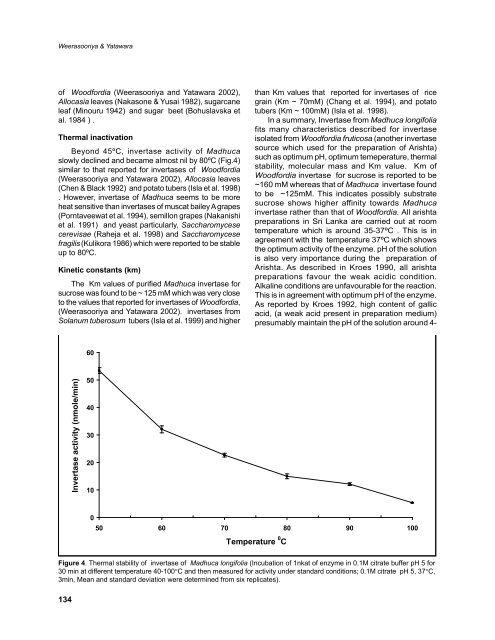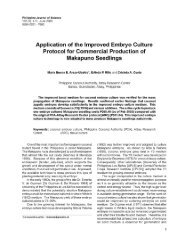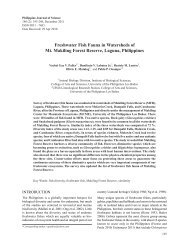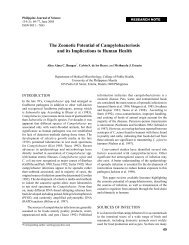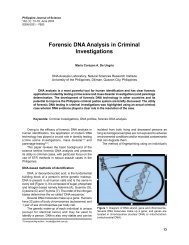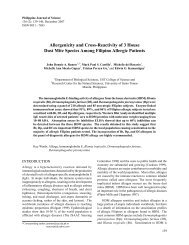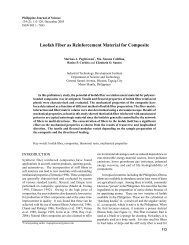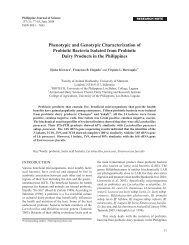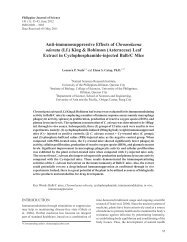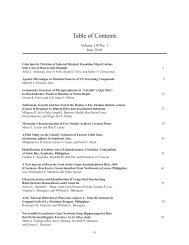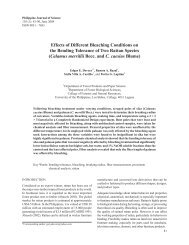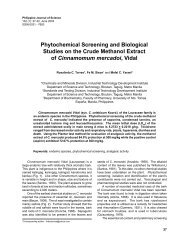Partial Purification and Characterization of Invertase - Philippine ...
Partial Purification and Characterization of Invertase - Philippine ...
Partial Purification and Characterization of Invertase - Philippine ...
You also want an ePaper? Increase the reach of your titles
YUMPU automatically turns print PDFs into web optimized ePapers that Google loves.
Weerasooriya & Yatawara<strong>of</strong> Woodfordia (Weerasooriya <strong>and</strong> Yatawara 2002),Allocasia leaves (Nakasone & Yusai 1982), sugarcaneleaf (Minouru 1942) <strong>and</strong> sugar beet (Bohuslavska etal. 1984 ) .Thermal inactivationBeyond 45ºC, invertase activity <strong>of</strong> Madhucaslowly declined <strong>and</strong> became almost nil by 80ºC (Fig.4)similar to that reported for invertases <strong>of</strong> Woodfordia(Weerasooriya <strong>and</strong> Yatawara 2002), Allocasia leaves(Chen & Black 1992) <strong>and</strong> potato tubers (Isla et al. 1998). However, invertase <strong>of</strong> Madhuca seems to be moreheat sensitive than invertases <strong>of</strong> muscat bailey A grapes(Porntaveewat et al. 1994), semillon grapes (Nakanishiet al. 1991) <strong>and</strong> yeast particularly, Saccharomycesecerevisae (Raheja et al. 1998) <strong>and</strong> Saccharomycesefragilis (Kulikora 1986) which were reported to be stableup to 80ºC.Kinetic constants (km)The Km values <strong>of</strong> purified Madhuca invertase forsucrose was found to be ~ 125 mM which was very closeto the values that reported for invertases <strong>of</strong> Woodfordia,(Weerasooriya <strong>and</strong> Yatawara 2002). invertases fromSolanum tuberosum tubers (Isla et al. 1999) <strong>and</strong> higherthan Km values that reported for invertases <strong>of</strong> ricegrain (Km ~ 70mM) (Chang et al. 1994), <strong>and</strong> potatotubers (Km ~ 100mM) (Isla et al. 1998).In a summary, <strong>Invertase</strong> from Madhuca longifoliafits many characteristics described for invertaseisolated from Woodfordia fruticosa (another invertasesource which used for the preparation <strong>of</strong> Arishta)such as optimum pH, optimum temeperature, thermalstability, molecular mass <strong>and</strong> Km value. Km <strong>of</strong>Woodfordia invertase for sucrose is reported to be~160 mM whereas that <strong>of</strong> Madhuca invertase foundto be ~125mM. This indicates possibly substratesucrose shows higher affinity towards Madhucainvertase rather than that <strong>of</strong> Woodfordia. All arishtapreparations in Sri Lanka are carried out at roomtemperature which is around 35-37ºC . This is inagreement with the temperature 37ºC which showsthe optimum activity <strong>of</strong> the enzyme. pH <strong>of</strong> the solutionis also very importance during the preparation <strong>of</strong>Arishta. As described in Kroes 1990, all arishtapreparations favour the weak acidic condition.Alkaline conditions are unfavourable for the reaction.This is in agreement with optimum pH <strong>of</strong> the enzyme.As reported by Kroes 1992, high content <strong>of</strong> gallicacid, (a weak acid present in preparation medium)presumably maintain the pH <strong>of</strong> the solution around 4-60<strong>Invertase</strong> activity (nmole/min)5040302010050 60 70 80 90 100Temperature 0 CFigure 4. Thermal stability <strong>of</strong> invertase <strong>of</strong> Madhuca longifolia (Incubation <strong>of</strong> 1nkat <strong>of</strong> enzyme in 0.1M citrate buffer pH 5 for30 min at different temperature 40-100°C <strong>and</strong> then measured for activity under st<strong>and</strong>ard conditions; 0.1M citrate pH 5, 37°C,3min, Mean <strong>and</strong> st<strong>and</strong>ard deviation were determined from six replicates).134


